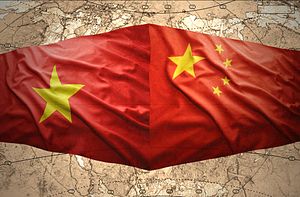It’s been over a month since a Chinese oil rig began drilling in waters Vietnam claims as part of its Exclusive Economic Zone (EEZ). The move sparked naval clashes and violent anti-China protests, and the crisis shows no signs of abating. On the contrary, both Vietnam and China are increasingly turning abroad to support their conflicting narratives.
Vietnam has been seeking outside support since the very beginning, as evidenced by its strategy of filming naval confrontations with Chinese vessels and releasing the footage. Vietnamese leaders, all the way up to Prime Minister Nguyen Tan Dung, have explicitly called on the international community “to continue strongly demanding China” stop its violations of international maritime law.
For nearly a month, China was content to rebut Vietnam’s accusations in regular press conferences and Chinese media articles. However, China is increasingly ramping up its own efforts to win the war for international opinion. China’s Foreign Ministry released a lengthy document outlining China’s claims to the Paracel Islands and cataloging Vietnamese provocations. In addition, as Zach noted, China asked UN Secretary General Ban Ki-moon to circulate the document in the UN General Assembly. That may have been a direct response to Vietnam’s own efforts to reach out to the UN through a diplomatic note.
Amidst the completing claims, it can be difficult to realize that Vietnam and China are describing the same events. Vietnam says that Chinese naval ships are aggressively patrolling the waters near the rig, and have repeatedly rammed and otherwise harassed Vietnamese boats. China, through a Foreign Ministry spokesperson, flatly denied that China has any “warships” in the area, although it acknowledges that “government vessels” have been sent to the area “due to Vietnam’s continuous, forceful, and illegal disruptions.” According to China, Vietnamese ships are responsible for the ramming incidents.
In the PR war, China has increasingly begun started to leverage the May anti-China riots in Vietnam to its advantage. Protests against China’s oil rig turned violent in mid-May, with protestors looting and burning foreign factories (many of which were Taiwanese and South Korean rather than Chinese). In the immediate aftermath of the riots, China limited itself to demanding increased security measure to protect Chinese citizens, as well as calling for Hanoi to compensate affected firms for their losses. Now, however, China has started directly accusing Vietnam’s government of “condoning” the riots.
This is no coincidence. From the beginning, China carefully controlled the story of the riots, resulting in Xinhua’s first news reports being released significantly later than stories from Taiwanese media outlets. That China is now consistently blaming Hanoi directly for the riots (not just for failing to prevent them, but for actively encouraging them) represents a new step in the campaign for international opinion.
China is not only hitting back at Vietnam with rhetoric, either. South China Morning Post reports that the Ministry of Commerce has banned state-owned enterprises from bidding on contracts in Vietnam. Vietnam’s transport minister downplayed the significance of the move, saying that the void left by Chinese firms could easily be filled by investors from other countries. While China is Vietnam’s top trading partner, its share of Vietnam’s foreign direct investment is much smaller, only ranking 11th in 2012.
China’s increased campaign against Vietnam is likely not meant to change any minds. Beijing is well aware that many of the major regional players, including Japan and the United States, will not be swayed by China’s arguments. Geoopolitics is the major factor here, no matter how many moral arguments both Beijing and Hanoi use against each other. However, by hitting back against Vietnam, China reminds everyone that there are two sides to this story — and provides countries that are dependent on economic and political ties with China with moral justification for backing Beijing in the clash.

































